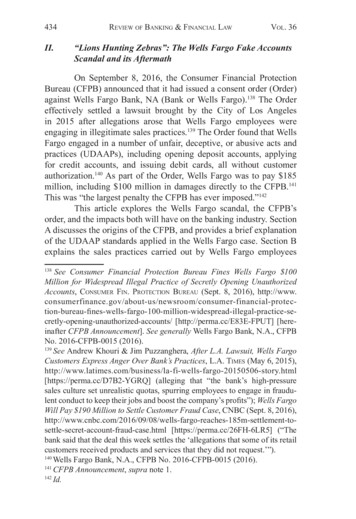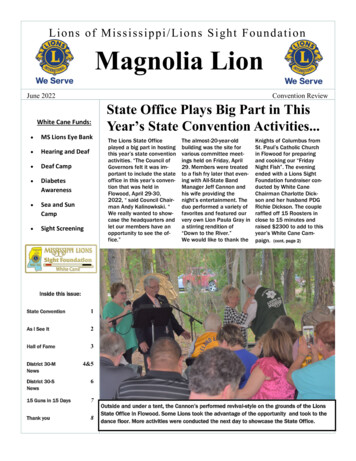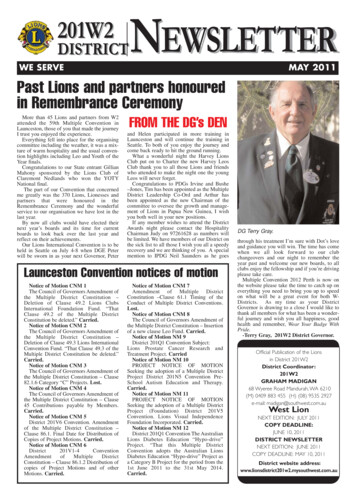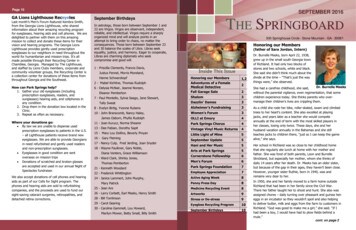
Transcription
434II.Review of Banking & Financial LawVol. 36“Lions Hunting Zebras”: The Wells Fargo Fake AccountsScandal and its AftermathOn September 8, 2016, the Consumer Financial ProtectionBureau (CFPB) announced that it had issued a consent order (Order)against Wells Fargo Bank, NA (Bank or Wells Fargo).138 The Ordereffectively settled a lawsuit brought by the City of Los Angelesin 2015 after allegations arose that Wells Fargo employees wereengaging in illegitimate sales practices.139 The Order found that WellsFargo engaged in a number of unfair, deceptive, or abusive acts andpractices (UDAAPs), including opening deposit accounts, applyingfor credit accounts, and issuing debit cards, all without customerauthorization.140 As part of the Order, Wells Fargo was to pay 185million, including 100 million in damages directly to the CFPB.141This was “the largest penalty the CFPB has ever imposed.”142This article explores the Wells Fargo scandal, the CFPB’sorder, and the impacts both will have on the banking industry. SectionA discusses the origins of the CFPB, and provides a brief explanationof the UDAAP standards applied in the Wells Fargo case. Section Bexplains the sales practices carried out by Wells Fargo employeesSee Consumer Financial Protection Bureau Fines Wells Fargo 100Million for Widespread Illegal Practice of Secretly Opening UnauthorizedAccounts, Consumer Fin. Protection Bureau (Sept. 8, 2016), ly-opening-unauthorized-accounts/ [http://perma.cc/E83E-FPUT] [hereinafter CFPB Announcement]. See generally Wells Fargo Bank, N.A., CFPBNo. 2016-CFPB-0015 (2016).139See Andrew Khouri & Jim Puzzanghera, After L.A. Lawsuit, Wells FargoCustomers Express Anger Over Bank’s Practices, L.A. Times (May 6, RQ] (alleging that “the bank’s high-pressuresales culture set unrealistic quotas, spurring employees to engage in fraudulent conduct to keep their jobs and boost the company’s profits”); Wells FargoWill Pay 190 Million to Settle Customer Fraud Case, CNBC (Sept. 8, ud-case.html [https://perma.cc/26FH-6LR5] (“Thebank said that the deal this week settles the ‘allegations that some of its retailcustomers received products and services that they did not request.’”).140Wells Fargo Bank, N.A., CFPB No. 2016-CFPB-0015 (2016).141CFPB Announcement, supra note 1.142Id.138
2016-2017Developments in Banking Law435and the resulting Order against Wells Fargo. Section C analyzes theimmediate fallout from the Order, including the Order’s effect on theBank, subsequent investigations by government agencies, and privatelawsuits. Finally, Section D considers the broader effect the Order hason the banking industry.A.The Consumer Financial Protection BureauThe CFPB was created as part of the Dodd Frank Wall StreetReform and Consumer Protection Act (Dodd-Frank),143 which wasenacted in 2010 in large part as a response to the 2008 financial crisis.144The CFPB’s stated purpose is to “implement and, where applicable,enforce Federal consumer financial law consistently for the purposeof ensuring that all consumers have access to markets for consumerfinancial products and services and that markets for consumer financialproducts and services are fair, transparent, and competitive.”145 TheCFPB has direct supervision over insured financial entities with over 10 billion in assets.146In addition to its supervisory authority, the CFPB is authorizedto investigate violations of consumer protection laws, which includeTitle X of Dodd-Frank,147 along with a list of other “enumeratedconsumer laws.”148 These investigations may be carried out solelyby the CFPB or jointly with other agencies or parties.149 The CFPBis also authorized to bring both administrative proceedings and civilactions.150 In such proceedings, the CFPB may seek a number ofdifferent remedies, both at law and in equity.15112 U.S.C. § 5491 (2012).See Mark Koba, Dodd Frank Act: CNBC Explains, CNBC (May 11, 2012),http://www.cnbc.com/id/47075854 [https://perma.cc/UAN4-VCVE].145§ 5511(a).146Id.147Dodd Frank Wall Street Reform and Consumer Protection Act, Pub. L. No.111-203, §§ 1001–1100H (2010) (12 U.S.C. § 1591 et seq.) (establishing,among other things, the CFPB and the UDAAP standard).14812 U.S.C. § 5511(c) (2012) (describing the primary functions of theCFPB); §§ 5481(12), (14) (defining “enumerated consumer laws” and “federal consumer financial law”).149§ 5562(a)(1).150§§ 5563–64.151§ 5565(a).143144
436Review of Banking & Financial Law1.Vol. 36UDAAPsTitle X prohibits UDAAPs in connection with consumerfinancial products and services.152 There are separate legal standardsfor what constitutes an unfair, deceptive, or abusive practice, and aviolation of one can be found absent violations of the others.153An act or practice is “unfair” if: (1) it “causes or is likely tocause substantial injury to consumers,” (2) the injury is “not reasonablyavoidable by consumers,” and (3) the “injury is not outweighed bycountervailing benefits to consumers or to competition.”154 Generallyspeaking, the “substantial injury” consumers suffer is financial innature.155 An injury can be “substantial” if it “causes a small amountof harm to a large number of people.”156 The CFPB acknowledges that“consumers cannot avoid injury if they are coerced into purchasingunwanted products or services or if a transaction occurs without theirknowledge or consent.”157 Finally, a finding of an unfair act or practicerequires the act or practice to cause a net injury (i.e., the injury causedby the action is not outweighed by the benefit of the action).158An act or practice is considered “deceptive” when: “(1) Therepresentation, omission, act or practice misleads or is likely to misleada consumer; (2) The consumer’s interpretation of the representation,omission, act, or practice is reasonable under the circumstances;and (3) The misleading representation, omission, act, or practice ismaterial.”159 Typical examples of deceptive acts or practices includemisrepresentations and inadequate disclosures.160Finally, an abusive act or practice is one that “materiallyinterferes with the ability of a consumer to understand a term orcondition of a consumer financial product or service.”161 Generally, an§ 5531.See Consumer Fin. Protection Bureau, CFPB Supervision and Examination Manual, UDAAP 1–10 (2012), http://files.consumerfinance.gov/f/201210 cfpb supervision-and-examination-manual-v2.pdf [https://perma.cc/4SPZ-5V98] [hereinafter CFPB Manual].154§ 5531(c).155CFPB Manual, supra note 16, at UDAAP 2.156Id.157Id.158Id.159Id. at UDAAP 5.160Id. at UDAAP 7–8.16112 U.S.C. § 5531(d)(1) (2012).152153
2016-2017Developments in Banking Law437abusive act or practice “takes unreasonable advantage of” a consumer’slimited financial knowledge, experience, or trust.162 The CFPBmanual contains no clarifications on what constitutes “unreasonableadvantage.”163B.Wells FargoWells Fargo was founded in 1852, primarily to serve thewestern United States.164 As of the third quarter of 2016, when theOrder was issued, Wells Fargo ranked third in bank size, measuredby deposits among all FDIC-insured institutions.165 At the time, WellsFargo had 1.9 trillion in assets under supervision, and had a businessrelationship with one third of American households.166 Industry expertshave noted that the Bank is a “profit-making machine,” primarily dueto an “aggressive sales culture.”167 This aggressive culture is at theheart of Wells Fargo’s accounts scandal and the resulting Order.168See § 5531(d)(2) (explaining that an abusive act or practice “takes unreasonable advantage of (A) a lack of understanding on the part of the consumerof the material risks, costs or conditions of a product or service; (B) the inability of the consumer to protect the interests of the consumer in selecting orusing a consumer financial product or service; or (C) the reasonable relianceby the consumer on a covered person to act in the interests of the consumer.”).163See generally CFPB Manual, supra note 16.164History of Wells Fargo, Wells Fargo, / [https://perma.cc/CY58-7VXD].165Wells Fargo, Wells Fargo Today: 3rd Quarter 2016 Quarterly FactSheet 2 (2016) /corporate/wells-fargo-today.pdf [https://perma.cc/BRP4-UVXU] (announcing thatWells Fargo was third in total deposits).166Id. at 2–3.167Michael Corkery, Wells Fargo Struggling in Aftermath of Fraud Scandal,N.Y. Times: DealBook (Jan. 13, 2017), ok/wells-fargo-earnings-report.html? r 1[http://perma.cc/5AF5-ETB8].168See Wells Fargo Bank, N.A., CFPB No. 2016-CFPB-0015 (2016).162
438Review of Banking & Financial Law1.Vol. 36The Violations“The analogy I use was that it was like lions huntingzebras . . . . They would look for the weakest, the onesthat would put up the least resistance.”169Wells Fargo had always sought to “distinguish itself in themarketplace as a leader” in what is known as cross selling.170 Crossselling, the so-called “Holy Grail” of banking, entails expandinga customer’s relationship through the sales of multiple accounts orservices.171 Former Wells Fargo CEO John Stumpf claimed that WellsFargo’s “goal is to have as deep a relationship as we can with . . .households.”172 Wells Fargo saw cross selling as a way to promotetrust in the bank.173 In an effort to further their cross selling strategy,Wells Fargo employees were encouraged to sign customers up for asmany as eight separate financial products, with the Bank claiming that“eight is great.”174 While more accounts may have promoted a greaterrelationship of trust between Wells Fargo and their customers, moreaccounts also meant more fees for the bank.175See Stacy Cowley, ‘Lions Hunting Zebras’: Ex-Wells Fargo Bankers Describe Abuses, N.Y. Times: DealBook (Oct. 20, 2016), ribe-abuses.html [https://perma.cc/5SAR-U8K3].170CFPB Announcement, supra note 1.171See Rachel Louise Ensign, What the Wells Fargo Cross-Selling MessMeans for Banks, Wall St. J. (Sept. 15, 2016), s://perma.cc/6JTH-ZGJR] (“Cross-selling at a bank is ‘kind of like atMcDonald’s, where they ask Would you like french fries with your cheeseburger?’”).172Holding Wall Street Accountable: Investigating Wells Fargo’s Openingof Unauthorized Customer Accounts Before the H. Comm. on Fin. Servs.,114th Cong. 2 (2016) (testimony of John Stumpf, Chairman & Chief Executive Officer, Wells Fargo), hrg-114-ba00-wstate-jstumpf-20160929.pdf [http://perma.cc/3H7F-DL5A][hereinafter House Hearing].173Id.174Evan Weinberger, Top House Dem Aims To Break Up Wells Fargo, Law360(Sept. 29, 2016, 4:31 PM), m-aims-to-break-up-wells-fargo [https://perma.cc/DWL6-SDLU].175Diana Novak Jones, Chicago Suspends Wells Fargo From City BusinessFor A Year, Law360 (Oct. 5, 2016, 6:49 PM), https://www.law360.com/ar169
2016-2017Developments in Banking Law439In an effort to incentivize employees to cross-sell products,Wells Fargo “based a portion of employees’ compensation on thenumber of accounts” they sold.176 This compensation program was theultimate impetus of the Wells Fargo scandal.177 Some commentatorsbelieve that, at its heart, the scandal was never an attempt to defraudWells Fargo customers of their hard-earned money, but rather aneffort by employees to exploit the Bank’s poorly monitored incentivecompensation program.178From January 1, 2011 to September 8, 2016, the CFPBestimated that Wells Fargo employees opened roughly 1.5 milliondeposit accounts that may not have been authorized by customers.179Additionally, Wells Fargo employees applied for approximately565,000 potentially unauthorized credit cards, issued debit cardswithout customer’s “knowledge or consent,” and enrolled customers inonline banking without their knowledge.180 In some cases, employeeswould use email addresses such as “noname@wellsfargo.com” toopen fraudulent accounts.181 In others, Wells Fargo employees wouldcreate PIN numbers for customer debit cards without the customers’knowledge.182 The practice of assigning fake PIN numbers extendedbeyond debit cards, as Wells Fargo employees would also assign fakePIN numbers, such as “0000,” to enroll customers in online banking.183Further, employees engaged in a practice called sandbagging, QQ39].176Id.177See Corkery, supra note 30.178See, e.g., Evan Weinberger, Wells Fargo Fraud Exposes Soft Spot In BankSupervision, Law360 (Sept. 16, 2016, 8:27 PM), ://perma.cc/8PHF-V7YN] (“‘It’s an interesting case because, as I seeit, it’s not a scheme devised to defraud customers of money, per se. It’s likean internal fraud used to game the incentive structure,’ said David Gibbons, asenior adviser at Alvarez & Marsal and a former top OCC official.”).179Wells Fargo Bank, N.A., CFPB No. 2016-CFPB-0015, ¶ 16 (2016).180Id. ¶ 23181Weinberger, supra note 41.182CFPB Announcement, supra note 1.183Cara Mannion, Wells Fargo Faces Suit Over Phony Accounts Scandal,Law360 (Oct. 19, 2016, 7:06 PM), rma.cc/CY6M-BYMA].
440Review of Banking & Financial LawVol. 36legitimate customer account openings would be delayed so as to fallunder a new sales reporting period for the employee.184 Other employeeswould falsely inform customers that certain banking services had tobe purchased in bundles with other banking services.185 All the while,Wells Fargo “continued to promote and monetarily reward” theseemployees, and “rewarded its managers and senior executives withmillions in bonuses.”186While the opening of fraudulent accounts alone was asignificant issue, employees would often engage in the prohibitedpractice of simulated funding.187 Employees needed to engage insimulated funding in efforts to earn their commission on the accounts,since the account needed to be “funded shortly after opening” inorder to qualify.188 This practice of simulated funding for fraudulentlyopened accounts led employees to withdraw customers’ moneyfrom their legitimate accounts to fund the fraudulently openedones.189 Without the money in their legitimate accounts, customerswould sometimes be charged overdraft or insufficient funds fees.190Customers with fraudulently opened credit cards also incurred variousfees and charges.191 These led customers to unknowingly “spendmoney on monthly service payments for accounts they did not want,jeopardizing their credit scores and forcing them to fight with debtcollection agencies for fees charged on unauthorized accounts.”192Evidence after the scandal suggested that Wells Fargo employeeswould take advantage of especially vulnerable populations, includingNative Americans, Mexicans, the elderly, and college students.1932.The Consent OrderAs a condition of the Order, Wells Fargo neither admittednor denied any of the findings of fact or conclusions of the CFPB,Id.Id.186Jones, supra note 38; Mannion, supra note 46.187House Hearing, supra note 35, at 2.188Wells Fargo Bank, N.A., CFPB No. 2016-CFPB-0015, ¶ 10 (2016).189Id.190Id. ¶ 16.191Id. ¶ 23.192Mannion, supra note 46.193See Cowley, supra note 32.184185
2016-2017Developments in Banking Law441but nevertheless consented to take the remedial actions.194 The CFPBassessed whether each type of fraud constituted a UDAAP of anytype.195 Ultimately, the CFPB found that: (1) the unauthorized depositaccounts and credit cards, as well as simulated funding, constitutedboth an unfair and abusive act and practice; (2) the unauthorizedenrollment in online banking services constituted an abusive act andpractice; and (3) the unauthorized debit cards and associated PINsconstituted an abusive act and practice.196The penalties levied against Wells Fargo included bothfinancial penalties and the institution of a compliance plan.197 In total,Wells Fargo had to pay 185 million, including a 100 million civilpenalty to the CFPB.198 Wells Fargo cannot claim any tax deductions,write-offs, or benefits by virtue of paying the penalty.199 Additionally,Wells Fargo is not allowed to argue in any subsequent proceedingbased on the scandal that it is entitled to a penalty offset in a later casedue to the civil penalty paid to the CFPB.200 In any case where WellsFargo nevertheless receives such a penalty offset, they must “notifythe [CFPB], and pay the amount of the [p]enalty [o]ffset to the U.S.Treasury.”201In addition to the monetary penalties, the CFPB requiredWells Fargo to establish a fund for the purpose of providing redress tothose customers affected by the scandal.202 This included an obligationto “refund all affected consumers the sum of all monthly maintenancefees, nonsufficient fund fees, overdraft charges, and other fees theypaid because of the creation of the unauthorized accounts.”203 As ofthe fourth quarter of 2016, Wells Fargo had already returned aroundWells Fargo Bank, N.A. CFPB No. 2016-CFPB-0015, ¶ 2 (2016).See id. ¶¶ 16–37 (analyzing individually, the unauthorized deposit accounts and simulated funding, the unauthorized credit cards, the unauthorizedenrollment for online banking services, and the unauthorized debit cards).196Id.197Id.198CFPB Announcement, supra note 1.199Wells Fargo Bank, N.A. CFPB No. 2016-CFPB-0015, ¶ 60 (2016).200Id. ¶ 61.201Id.202See id. ¶ 49 (“Within 10 days of the Effective Date, Respondent mustreserve or deposit into a segregated deposit account an amount not less than 5 million, for the purpose of providing redress to Affected Consumers asrequired by this Section.”).203CFPB Announcement, supra note 1.194195
442Review of Banking & Financial LawVol. 36 3.2 million to customers.204 Additionally, the Bank established a freemediation program for affected customers.205Finally, the Order included a series of provisions related to theimplementation of an independent review and a compliance plan forWells Fargo’s future.206 As a condition of the Order, Wells Fargo wasobligated to retain an independent consultant to conduct a review ofthe Bank’s sales practices within the Community Bank Regional BankBranch Network.207 Wells Fargo is required to correct any deficienciesidentified in the independent review.208 Finally, the CFPB’s RegionalDirector retains the right to object to or modify anything contained inthe compliance plan.209 In response, Wells Fargo has hired two outsideconsultants: the first to meet the aforementioned requirements underthe Order, and the second to review company-wide sales practices.210In April 2017, Wells Fargo released the results of the sales practicesinvestigation report, conducted by Shearman & Sterling, whichidentified “sales misconduct” dating back to at least 2002.211C.The Fallout1.Effect on Wells FargoAs news of the scandal broke, Wells Fargo began to sufferfinancially and through the loss of its leadership.212 Former CEO JohnEvan Weinberger, Wells Fargo Says Account Scandal Recovery Moving Along, Law360 (Jan. 13, 2017, 7:11 PM), //perma.cc/SN5F-BCPU].205Id.206Wells Fargo Bank, N.A., CFPB No. 2016-CFPB-0015 (2016).207Id. ¶ 39.208Id. ¶ 42.209Id. ¶ 50.210Weinberger, supra note 67.211See Indep. Dirs. of the Bd. of Wells Fargo & Co., Sales Practices Investigation Report 73 (2017), t.pdf[https://perma.cc/N78G-DWCY] (“Employment Section lawyers encountered salesmisconduct and the termination of several employees at one time (discussedwithin the Law Department as “mass terminations”), dating back at least to2002.”).212Kat Greene, Wells Fargo CEO Retires Amid Fraudulent Accounts Scandal,Law360 (Oct. 12, 2016, 5:56 PM), https://www.law360.com/articles/850908/204
2016-2017Developments in Banking Law443Stumpf resigned on October 12, 2016 in the wake of numerous claimsthat he shirked his responsibilities in allowing such events to occur.213As part of his resignation, Stumpf “agreed to forfeit 41 millionin unvested equity awards,” give up his 2016 bonus, and waive aseverance package.214 In April 2017, Wells Fargo announced that theyhad “clawed back an additional 28 million” from Stumpf.215 Stumpfwas replaced by Tim Sloan as CEO of Wells Fargo, and Stephen Sangeras the board of director’s chairman, effectively splitting Stumpf’sformer role.216 While many felt as though Stumpf’s resignation was anecessary step in the remediation of the Wells Fargo name, others feltas though simply resigning was not enough.217 In addition to Stumpfleaving the Bank, Wells Fargo fired upwards of 5,300 employees whowere involved in the scandal, reduced top management’s 2016 ounts-scandal [https://perma.cc/G4YT-9VFZ].213E.g., id. (“Mr. Stumpf bears direct responsibility for failing to stop thisfraud from proliferating under his leadership.”); Weinberger, supra note 37(“It’s just beyond credibility that somebody up the food chain either didn’torder this, condone this or turn a blind eye to this . . . . ”); see Evan Weinberger, Stumpf’s Departure Won’t Ease Pressure On Wells Fargo, Law360 (Oct.13, 2016, 5:33 PM), parture-won-t-ease-pressure-on-wells-fargo [https://perma.cc/QHB5-W327](“‘I have decided it is best for the company that I step aside.’”).214Brandon Lowrey, Wells Fargo CEO’s Retirement Leaves Questions,Sens. Say, Law360 (Oct. 20, 2016, 7:27 PM), -ceo-s-retirement-leaves-questions-sens-say [https://perma.cc/F6J6-7M5W] (describing how Stumpf would forfeit the equityawards and “forego a bonus for 2016”); Greene, supra note 75 (indicatingthat Stumpf would not receive a severance package).215Laura J. Keller, Wells Fargo Board Claws Back 28 Million More FromEx-CEO, Bloomberg L.: Big L. Bus. (Apr. 10, 2017), 8-million-more-from-ex-ceo/ [https://perma.cc/PFF3-LWZK].216Greene, supra note 75; see Evan Weinberger, Wells Fargo Account Openings Fall After Settlement, Law360 (Oct. 14, 2016, 5:27 PM), -account-openings-fall-after-settlement [https://perma.cc/N4HN-ECFT].217See, e.g., Lowrey, supra note 77 (lamenting that “[a] bank teller would facecriminal charges and a prison sentence for stealing a handful of 20s from thecash drawer. A bank CEO should not be able to oversee a massive fraud andsimply walk away to enjoy his millions in retirement.”).
444Review of Banking & Financial LawVol. 36by 32 million, and cancelled 47 million of stock options held by theformer head of the community bank division.218Wells Fargo also made permanent changes to its employeecompensation system.219 In September 2016, Wells Fargo announcedthat it “would eliminate all of the product and sales goals in its retailbanking unit starting in January,” and later moved that date up toOctober 1, 2016.220 Now, “employees will be judged on customerfeedback, product usage and the performance of their team, andbranch goals rather than individual product sales . . . .”221 Finally, theBank raised the minimum wage for approximately 26,000 branchemployees from 13.50 to 17 per hour.222The scandal also significantly impacted Wells Fargo’s bottom223line. The changes to the monitoring and compliance programrequired by the Order alone could cost the Bank “tens of millions ofdollars.”224 Furthermore, a survey suggested that Wells Fargo “couldlose as much as 212 billion in deposits and 8 billion in revenue”in the year and a half following the scandal.225 This loss wouldrepresent a 17 percent decrease in deposits and a 9 percent decrease inrevenue.226 Approximately 14 percent of customers responding to thesurvey stated that they had “decided to bank elsewhere.”227 Consultingfirm Cg42 claimed in the worst-case scenario as many as 30 percent ofMatt Egan, Wells Fargo strips CEO and 7 top execs of 2016 bonuses,CNN Money (Mar. 1, 2017), rgo-strips-ceo-bonus-fake-account-scandal/?iid EL[https://perma.cc/5LC6-8RSM]; Keller, supra note 78; Martin O’Sullivan, SEC, DOJInvestigating Wells Fargo Over Account Scandal, Law360 (Nov. 3, 2016,1:30 PM), estigating-wells-fargo-over-account-scandal [https://perma.cc/2SE5-TPH5].219See Greene, supra note 76.220Id.; House Hearing, supra note 35, at 5.221Weinberger, supra note 67.222Id.223Lucinda Shen, Wells Fargo’s Scandal Could End Up Costing Bank 8Billion, Fortune: Fin. (Oct. 24, 2016), -could-end-up-costing-bank-8-billion/ [http://perma.cc/VEZ7-UPJM].224Weinberger, supra note 79.225Shen, supra note 86.226Id.227Id.218
2016-2017Developments in Banking Law445Wells Fargo customers could leave the bank.228 These concerns beganto materialize almost immediately after the scandal was announced.229Wells Fargo’s expense ratio, a measure of a bank’s expenses dividedby its revenue, was an abnormally high 61 percent.2302.Government ResponsePrior to resigning, John Stumpf was called to Capitol Hill totestify on behalf of Wells Fargo before both the Senate and the Houseof Representatives.231 In his testimony, Stumpf apologized, discussedcertain employee compensation policies, and explained some of thesteps Wells Fargo had taken to rectify the scandal.232 In response,many congressmen called for Stump’s resignation.233 Others called fora criminal probe into Wells Fargo executives.234 One congresswoman,Id.See Corkery, supra note 30 (describing that in the fourth quarter of 2016,“new credit card applications were down 43 percent” from a year ago, “newchecking account openings fell 40 percent” from a year ago, “[t]eller transactions fell 6 percent”, and “customer interactions with the bankers in thebranches declined 14 percent”).230See id.231See generally House Hearing, supra note 35; An Examination of WellsFargo’s Unauthorized Accounts and the Regulatory Response Beforethe S. Comm. on Banking, Hous., and Urban Affairs, 114th Cong. (2016)(testimony of John Stumpf, Chairman & Chief Executive Officer, WellsFargo),http://www.banking.senate.gov/public/ mony.pdf[https://perma.cc/K5LT-MVY6][hereinafter Senate Hearing]232See House Hearing, supra note 35, at 1 (“I am going to explain this morning what happened and what we have done about it. But first, I want to apologize to all Wells Fargo customers.”); Senate Hearing, supra note 94, at 1.233E.g., Maggie McGrath, Elizabeth Warren To Wells CEO Stumpf: YouShould Resign And Face Criminal Investigation, Forbes (Sept. 20, erma.cc/7MZZ-DXNG].234See, e.g., John Kennedy, Senate Dems Call For Criminal Probe Of WellsFargo Execs, Law360 (Oct. 5, 2016, 10:22 PM), s://perma.cc/Q3Z4-EG2U] (“Senate Democrats on Wednesday calledfor a criminal probe of Wells Fargo executives after revelations that thousands of accounts were opened without consumers’ permission, urging the228229
446Review of Banking & Financial LawVol. 36Maxine Waters, “the ranking Democrat on the House FinancialServices Committee, said she is drafting legislation to break up WellsFargo and potentially other banks.”235In addition to the hearings before Congress, separateinvestigations have been opened by various government agencies.236Wells Fargo revealed in a filing with the Securities and ExchangeCommission that it is under investigation by the agency.237 TheFinancial Industry Regulatory Authority (FINRA) has asked formeremployees to come forward if they believe that Wells Fargo wrongfullyfired them for trying to act as a whistleblower by reporting eventsrelated to the Order.238 The Department of Labor is conducting a“top-to-bottom” review of Wells Fargo to ascertain whether the Bankviolated labor laws “by forcing employees to work unpaid overtimeto meet the aggressive sales quotas.”239 Moreover, at least three U.S.Attorney’s Offices have opened investigations.240 Finally, the Office ofthe Comptroller of the Currency (OCC) is continuing its investigationdespite its involvement in the Order.241In addition to federal government agencies, at least two stateshave opened independent investigations into Wells Fargo.242 ThenU.S. Department of Justice to follow through on its year-old promise tostrengthen its pursuit of individual corporate wrongdoing.”).235See Weinberger, supra note 76 (claiming that “[i]t is unclear how such legislation would work, and with Congress out of session prior to November’selection, it is unclear when any bill will be introduced”).236See O’Sullivan, supra note 81.237Id.238Carmen Germaine, FINRA Seeks Information From Fired Wells Fargo Reps, Law360 (Dec. 9, 2016, 9:19 PM), erma.cc/4ZBB-SZ5U].239Id.240See Y. Peter Kang, W
II. "Lions Hunting Zebras": The Wells Fargo Fake Accounts Scandal and its Aftermath On September 8, 2016, the Consumer Financial Protection Bureau (CFPB) announced that it had issued a consent order (Order) against Wells Fargo Bank, NA (Bank or Wells Fargo).138 The Order effectively settled a lawsuit brought by the City of Los Angeles










